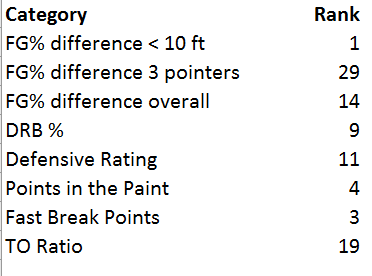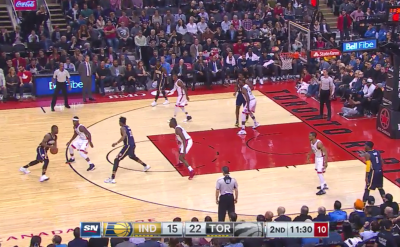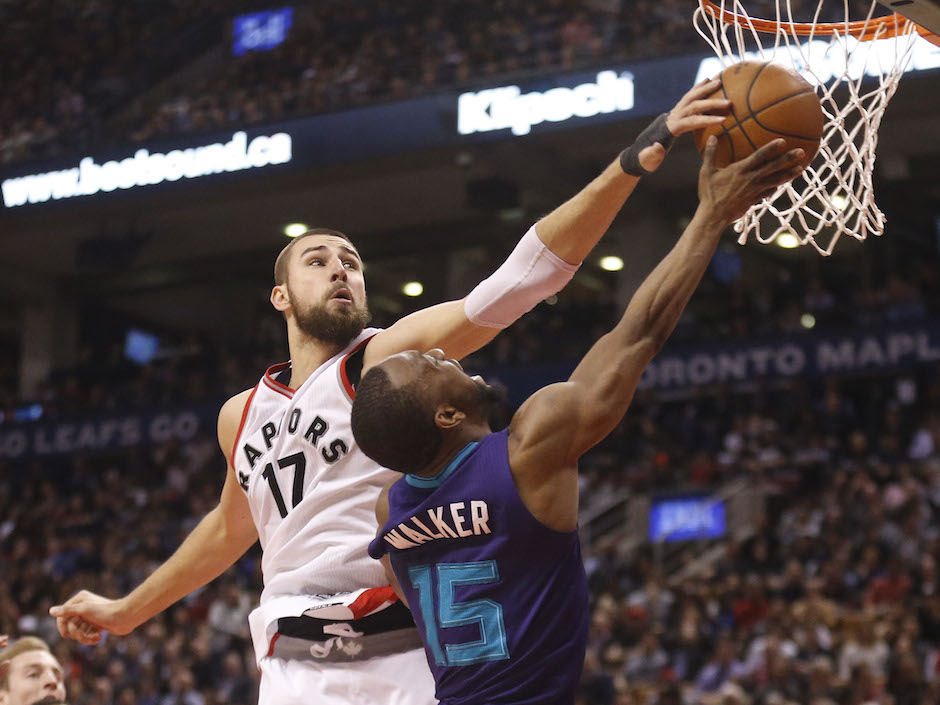It’s been a long road but the playoffs are finally on horizon. Over the course of the season there have been a lot of differing opinions about how good the Raptors are, what they do well and what they do poorly but the one thing that everyone seems to agree on is the importance of their defense. The offense can have its ups and downs, especially with the style the Raptors play, but when the defense holds up the Raptors are good enough to trade punches with every team in the league. Unfortunately the defense has been somewhat inconsistent, looking elite for some short stretches and terrible for some fairly long stretches. With the defense being the key to their postseason success it’s important to look at how the defense has fared since their midseason slide to the bottom of the defensive rankings.
The good news is the team recovered fairly well. Over the last 6 weeks of the season their defensive efficiency has ranked 10th in the NBA – not good enough to be elite, but good enough to keep them in games while the offense tries to figure out ways to score and right around where it was during their strong start. Their ranking in key categories for the season paints an accurate picture of their strengths and weaknesses:

Field goal percentage difference is the difference between the field goal percentage they allow and the average field goal percentage of the shooters they face. The Raptors are among the best at the rim but among the worst from outside and that averages out to be more or less average as far as percentages go. They protect their glass, clog the paint and slow the game down but they tend to overcommit to help on drives and they lose track of shooters pretty easily. It’s a conservative brand of defense, with the Raptors being more concerned with forcing bad shots than turning you over and running the floor.
The things they did poorly while the defense struggled still crop up every now and then, but part of it really does seem to be schematic because it occurs so frequently and even the best defenders on the Raptors do it. Kris Humphries doesn’t seem like enough of a threat to justify Patterson sinking down this far, but there he is, a few feet from the rim while Mike Scott spots up outside:
I guess there’s a chance that Patterson saw Humphries rolling to the rim and thought that he needed to be shut down at all costs but I highly doubt it. I like the consistent application of philosophy but in a 7 game series teams will look to exploit that the way the Hawks did on that possession. It’s not just that one possession though, it’s more of a recurring theme against good offensive teams:
Four Raptors defenders along the baseline while there are three shooters up high seems a little excessive.
The guards are still having difficult closing out under control, just not as frequently as they did before. It was most obvious against the Hawks, who spread the defense out and make them cover greater distances and rotate with greater frequency. It’s dangerous to combine this kind of reckless closeout with the Raptors tendency to sink to the rim on penetration, because chasing one man off the like this will just lead to an open three from another shooter as the defense collapses and scrambles to recover. DeRozan still needs to find the happy medium so he doesn’t let the likes of Kent Bazemore walk past him like this:
DeRozan seems to be the primary offender, matadoring for opposing guards on the regular but at least the Raptors big men have protected the paint well all season long. If a Raptors guard is going to make a mistake in that situation it’s probably better to close out too hard than not hard enough, but ideally DeRozan would be able to contain Bazemore all on his own.
The guards still display a tendency to fall asleep or get turned around when rotating, leading to a fair amount of blown coverages. The two most common mistakes are two players rotating to the same offensive player or the defender straight up falling asleep and having no idea where his man is:
As long as the Raptors guards defend like this the team is going to struggle to defend the three point line. Fortunately the Indiana Pacers squad they face in the first round doesn’t do much to exploit these weaknesses Their typical pick and roll set up doesn’t really require the kind of collapsing that you saw in those Hawks clips because there is typically a big man near the rim already and the defending big men can drop down further because the pick and pop is not much of a concern. On a play like this one Biyombo doesn’t have to worry much about rushing back to Turner so he’s already dropped back to the paint, allowing he and Ross to contain that pick and roll on their own:

If the Pacers are going to try to beat the Raptors with the likes of Myles Turner and Lavoy Allen popping out for jumpers I say let them try it. With big men who don’t need to be tracked carefully outside of 15 feet the Raptors big men will be able to hang back and protect the rim as they have all season without worrying about extending the defense outward. This will make things a lot easier for the guards, who won’t have to worry about helping inside and can concentrate on tracking shooters.
The Pacers are also light on three point shooting and don’t have the kind of active cutters like Doug McDermott and Kyle Korver that have bothered the Raptors all year. They have but three shooters to worry about: Paul George, George Hill and CJ Miles, and with George and Hill handling a lot of the ball-handling duties the Pacers have precious few shooters to space the floor. It’s the same problem that plagued the Raptors before Norman Powell discovered his stroke and DeMarre Carroll was out to injury. This lack of shooting with no developed interior offensive talent to worry about is a big part of the reason the Pacers ended the season with the 22nd ranked offense.
The Raptors defense has recovered nicely since we last looked at how it was performing but the Raptors still have issues on the perimeter that may be an issue should they progress in the playoffs. Thankfully they’ve drawn a first round opponent that lacks the personnel to exploit those weaknesses consistently, so the defense should hold firm in the first round. That doesn’t guarantee victory, of course, and plenty of preview material is coming your way to tell you what to expect in the upcoming first round series but we can rest a little easier knowing that the team is back to playing the tough defense that we saw in the first two months of the season.



